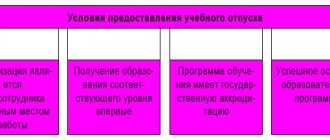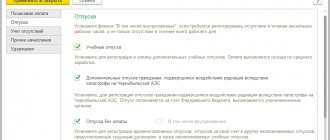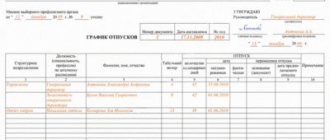Procedure for provision
In accordance with Art. 122 of the Labor Code of the Russian Federation, long rest is provided to the worker every year. When drawing up a schedule, it is not the calendar year that is taken into account, but the working year, which lasts 12 months from the date of entry to work at a specific enterprise. An employee’s first “vacation” right arises after six months of continuous work in one organization. By agreement of the parties, the employee has the right to take a long rest earlier.
In the future, the above-mentioned rule applies: each working year - one vacation (its duration varies depending on the category of worker, the minimum duration is 28 calendar days). Some categories of employees have benefits expressed in a longer duration of rest or preferential right to choose a vacation period; this must be taken into account when drawing up a schedule. Any violation of the right to rest is painfully perceived by employees and causes numerous lawsuits against employers. To prevent such violations, the Labor Inspectorate strictly monitors the relevant personnel documentation and punishes if it is completed incorrectly.
The Code of Administrative Offenses of the Russian Federation establishes the fine for the absence of a vacation schedule: this document must be drawn up every year no later than December 15.
Vacation schedule for 2020: features of preparation, form
Drawing up a vacation schedule is the responsibility of all employers, regardless of the number of employees in the company.
This document regulates the order of provision of paid leave in the calendar year and contains information about the time of distribution of rest for employees (Article 123 of the Labor Code of the Russian Federation).
When compiling it, the wishes of employees and the peculiarities of the work process are taken into account. Employers must have time to draw up a vacation schedule by December 17.
Features of vacation scheduling
The procedure for drawing up a vacation schedule can be established in a collective agreement, internal labor regulations or other local regulations. Moreover, Rostrud believes that each structural unit may have its own vacation schedule.
This is especially true for large companies with hundreds or thousands of employees.
In this case, the heads of departments prepare draft schedules, and then transfer the document to personnel officers, who, for their part, form a consolidated unified vacation schedule.
According to the accepted rule, the vacation schedule must contain information about the time and duration of vacation for each employee working under an employment contract.
Typically, the length of leave depends on the number of vacation days to which the employee is entitled and the number of unused vacation days as of January 1, 2020.
When drawing up a vacation schedule, do not forget about newcomers who have not worked for six months at the beginning of the calendar year.
As we know, the right to use vacation for the first year of work arises after six months of continuous work with a particular employer.
Therefore, when drawing up a schedule, it is important to take into account that newcomers can take advantage of the required rest days by the end of 2020.
Duration of basic annual leave for different categories of employees
There are several categories of employees who “stand out” from the general rule for drawing up a vacation schedule:
1. Employees who have the right to apply for paid leave upon application before the expiration of six months of continuous work.
https://youtu.be/_xv1ua6XwDs
Such employees are specified in Art. 122 Labor Code of the Russian Federation:
- women - before maternity leave or immediately after it;
- workers under 18 years of age;
- employees who adopted a child under 3 months of age.
According to Art. 123 of the Labor Code of the Russian Federation, at the request of the employee, he may be granted annual leave while his wife is on maternity leave, regardless of the time of his continuous work with the employer.
2. Part-timers.
According to Art. 286 of the Labor Code of the Russian Federation, leave for part-time workers is granted simultaneously with leave at the main place of work. If an employee has not worked for six months at a part-time job, then leave is granted in advance.
To take this category of employees into account in the vacation schedule, ask them for information about the vacation period at their main place of work.
3. Employees with many children with children under 12 years old.
Federal Law No. 360-FZ dated October 11, 2018 supplemented the Labor Code with Art. 262.2. Now employers need to take into account that parents of 3 or more children under the age of 12 have the right to take annual paid leave at their request at a time convenient for them.
The Letter of the Ministry of Labor of the Russian Federation dated November 20, 2018 N 14-2 / OOG-9166 clarifies that the age of children is calculated based on the year of leave. This means that if at the beginning of the year the leave was granted, an employee with many children had the right to use the leave at a convenient time, then this right is retained even if the eldest child is already 12 years old at the time the leave begins.
Automatic payroll for each employee - just confirm the amounts. Calculate sick leave and vacation in a few minutes.
Try it
In a review of current issues for February 2020, Rostrud considered the question of whether an employee with three children under the age of 12 can take leave at a convenient time in parts.
According to experts, the right to use vacation at a convenient time does not mean the right to divide the vacation into parts at the request of the employee. Such division in accordance with Art. 125 of the Labor Code of the Russian Federation is possible only by agreement of the parties.
In this case, one of the parts of the vacation must be at least 14 calendar days.
4. Veterans, employees awarded the “Honorary Donor of Russia” badge, employees raising a disabled child under the age of 18, spouses of military personnel.
All these categories of workers have the right to go on paid leave at a time convenient for them.
How to indicate the start date of a vacation in the vacation schedule
Rostrud believes that indicating only the month of vacation in the schedule, without the exact start and end dates of the vacation, is unlawful.
Experts recommend entering specific dates into the vacation schedule form to avoid disagreements with employees.
On the right to transfer vacation to the next year
It is quite possible that when drawing up a vacation schedule for 2020, some employee will send you an application asking not to grant him vacation next year, but to postpone it to 2021. This request must be answered with a refusal. This is what Rostrud experts advise to do.
They refer to the fact that paid annual leave must be provided every year. And if the transfer is allowed, it is only in exceptional situations (Article 124 of the Labor Code of the Russian Federation), which include, for example, production necessity and temporary disability of the employee.
Vacation schedule form
When drawing up a vacation schedule, you can use form T-7 (Resolution of the State Statistics Committee of the Russian Federation dated April 6, 2001 No. 26). At the vacation planning stage, columns 1 to 6 should be filled out.
Column 6 contains the start date of vacation for employees, including those who have the right to take vacation at any time convenient for them.
Columns 7, 8 and 9 are not filled in. The data in them is carried by hand throughout the year, as employees go on vacation.
Rostrud recommends adding an additional column “I am familiar with the schedule” to the form or drawing up a familiarization sheet, which will be an appendix to the vacation schedule. Do not forget that, according to Art. 123 of the Labor Code of the Russian Federation, each employee must be notified of the start time of vacation no later than two weeks before its start.
Until approval, the vacation schedule is just a draft. After it has been endorsed by the head of the personnel service and the heads of structural divisions, the document is sent to the trade union organization (Art.
372 of the Labor Code of the Russian Federation). Its confirmation is expressed in the format of an extract from the minutes of the meeting of the trade union committee. But today not every company has a trade union. Then you need to make a note about this in the approval line of the form.
Employees must be familiarized with the approved vacation schedule against signature. The document follows:
- store in the accounting and personnel departments;
- post in a convenient place for reference;
- send to the structural divisions of the company (copies of the schedule).
If the employer warned the employee about the start of the vacation later than two weeks before its start, the employee has the right to submit a written application requesting to postpone the vacation to another agreed date. At the same time, he may not write an application addressed to the employer to grant him leave if he uses it in accordance with the schedule.
There are several cases when an employee is required to apply for leave:
- vacation is used before six months of continuous work with the employer;
- vacation is used before six months of continuous work based on an agreement with the employer;
- the employee belongs to one of the categories to whom the employer is obliged to provide leave at a convenient time.
Changing the vacation schedule
Since the vacation schedule is a mandatory document not only for the employer, but also for the employee, if changes are made to it, agreement of the parties is required.
To record the transfer of vacations in the current calendar year in the T-7 form, columns 7-9 are used.
Column 10 (“notes”) should be used in the following cases:
- when vacation or parts thereof are postponed according to the reason indicated in Part 3 of Art. 124 of the Labor Code of the Russian Federation - the provision of leave may adversely affect the normal course of work of the organization;
- when vacation or parts thereof are postponed for the reason specified in Part 2 of Art. 125 of the Labor Code of the Russian Federation - recall from vacation and transfer of vacation to the next calendar year.
As a rule, new employees join the company throughout the year. In this regard, the question often arises: what to do if a person started working after the vacation schedule was approved? Rostrud relies on law enforcement practice in this matter and provides two options on its official website:
- make changes to the consolidated vacation schedule;
- draw up an additional schedule and attach it to the summary one.
Penalty for not having a vacation schedule
The absence of a vacation schedule is an administrative offense for which penalties are provided (Article 5.27 of the Code of Administrative Offenses of the Russian Federation) - a warning or the imposition of an administrative fine:
- for officials in the amount of 1,000 to 5,000 rubles;
- for entrepreneurs - from 1,000 to 5,000 rubles;
- for legal entities - from 30,000 to 50,000 rubles.
Penalty table
How will they be punished for failure to provide a worker with vacation rights for more than two years in a row, what are the consequences of not having a vacation schedule or not paying vacation pay? The amount of the sanction is specified in Art. 5.27 of the Code of Administrative Offenses of the Russian Federation, which provides for punishment for any violation of labor legislation.
| Nature of the violation | Responsibility measures |
| Failure to provide leave | Legal entity: 30,000-50,000 rubles, for a repeat - 50,000-70,000 rubles. Official: 1000-5000 rubles, for repeated - 10,000-20,000 rubles, possible disqualification for officials for a period of 1 to 3 years. |
| Responsibility of the employer for the lack of a vacation schedule | The first time a warning is possible. The fines are the same as above. A micro-enterprise has the right not to have a schedule (the order of rest is established by agreements). |
| Failure to adhere to schedule | The same fines + compensation for moral damage (by agreement with the employee). |
| Non-payment of holiday pay | Administrative fines:
Criminal punishment for a manager: up to 120,000 rubles. - for partial non-payment; up to 500,000 rub. - for complete non-payment. |
As you can see, the amount of the fine for the lack of a vacation schedule is established by the Code of Administrative Offenses the same as for other violations relating to the rights of employees. The exception is non-payment of vacation pay: here the penalties are noticeably higher.
When does the employer become liable for failure to provide leave?
An employee's vacation is related to payments. Payments are calculated based on average annual earnings (excluding social payments). It is also necessary to take into account that an important condition for an employee to go on vacation is the payment of vacation pay 3 days before the vacation, and for the delay of vacation pay, the employer may be subject to financial liability provided for by the Labor Code of the Russian Federation and expressed in compensation (not subject to personal income tax) for each day of delay in payments .
Administrative liability is also provided for late payment of vacation pay, so the employer needs to calculate all payments for the delay, if any, without waiting for State Tax Inspectorate checks.
READ MORE: Complaint to the prosecutor's office against an investigator who is inactive in a criminal case
The procedure for calculating vacation pay is regulated by Art. 139 of the Labor Code of the Russian Federation and the Regulations on average wages, which determines:
- the amount of payments to the employee for the year preceding the vacation
- number of calendar days to calculate average daily earnings
- Average daily earnings and vacation pay
At the same time, the employer, at its discretion, can create a reserve fund for vacation amounts or not.
If there is a vacation pay fund, then vacation pay is reflected: D 96 K 70
If there is no fund, then: D 20 (23, 26, 44, etc.) K 70
Personal income tax on vacation pay: D 70 K 68
| ★ Best-selling book “Calculating sick leave and insurance premiums in 2018” for dummies (understand how to calculate insurance premiums in 72 hours) 3,000 books purchased |
If an employee takes a vacation (of all the days that the employee has accumulated) with subsequent dismissal by agreement of the parties, then all calculations are made before going on vacation, because at the end of it the parties are already bound by labor obligations and the general calculation and execution of all necessary documents need to be done last. working day before vacation.
The Labor Code establishes an annual 28-day rest period for all employees; in cases specified by law, this period is increased by additional vacations. The right to leave for a new employee arises after six months of work in the company, and for some categories (pregnant women, minors, etc.) before the expiration of this period.
The employer must maintain a vacation schedule, which indicates when and which employee goes on vacation in the current year. This document is mandatory for both the employer and the employee. Accordingly, if an employee wants to go on vacation at a time other than the schedule, the employer has the right to refuse him. At the same time, the employee must be sent on vacation exactly during the period indicated in the schedule (Article 123 of the Labor Code of the Russian Federation).
Legal transfer of vacation to the next year is allowed in case of production necessity, when the absence of an employee may adversely affect the work process. This requires his written consent, and the leave must be granted before the expiration of a year after the period for which it is due (Article 124 of the Labor Code of the Russian Federation).
https://youtu.be/TCRr9O4yOCg
If the employee himself does not want to rest
In this case, he should be forcibly sent on long rest and familiarized with the instructions and orders. Even if the employee does not want to exercise his right, this will not become a mitigating circumstance when imposing a fine. Be sure to record going to work on rest days and, if possible, stop work activity, even threatening disciplinary action. Violation of the schedule for taking time off is a disciplinary violation, since it contradicts the approved Labor Regulations and other local regulations of the enterprise.











